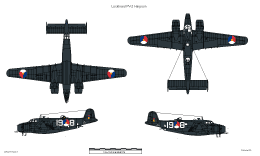Nederlandse Modelbouw en Luchtvaartsite
Dutch Modelling and Aviation
Lockheed PV-2 Harpoon
Page 2 of 6
In 1949 the NATO was established. The Netherlands would participate in the protection of the North Sea and the Canal and also contribute to the protection of the routes in the eastern part of the Atlantic ocean. The anti submarine warfare was very important and it was necessary to acquire long range patrol aircraft. The MDAP (Mutual Defence Assistance Program) was very welcome.
The staff of the RNlNAS (MLD) hoped to get the new Lockheed P2V-5 Neptune, this was the best ASW aircraft at that time, but this type was just introduced at the US Navy and unavailable at that moment, so as an interim solution 18 PV-2 Harpoons were delivered.
April 245, 1951 30 men left and travelled to the US to receive their training at the NARTU (Naval Air Reserve Training Unit) at N.A.S. (Naval Air Station) Norfolk. The Harpoons were, symbolically, handed over to the RNLNAS on July 12, 1951.
The first Harpoons were already taken over on June 26, 1951 at Alameda. The first six aircraft , S-1 till S-4, S-7 and S-8, were flown to the Netherlands on August 31, 1951 via Iceland. They arrived at naval air station Valkenburg on September 7, 1951.
[door Polygoon-Profilti (producent) / Nederlands Instituut voor Beeld en Geluid (beheerder), is gelicenseerd onder Creative Commons - Naamsvermelding-Gelijk delen.]
The official transfer by the MAAG (Mutual Assistance Advisory Group) was September 24, 1951.
The second group, S-9 till S-14 departed October 1951 from California via the Azores and Morocco and arrived at Valkenburg on November 2, 1951.
The third and last group arrived December 24, 1951 at Valkenburg.
The ferry flights were made by the same crews.
From September 1951 it was a very busy period because all the training that had to be done. December 15, 1951 320 squadron was operational on the PV-2 with nine crews. Now the squadron was operational, it participated in several NATO drills and was often detached at other NATO air bases.
During the flood in February 1953 one Harpoon operated as communication aircraft. Four till six aircraft were used for search duties.
Also several courses were done, such as JASS--course at HMS Eagle near Londonderry (JASS = Joint Anti-Submarine School).
Updating and modernization
Spring 1952 S-16 and S-18 were modified at Avio-Diepen with a sonobuoys. In February 1953 S-17 was modified. The test were satisfying and in July 1953 Harpoons S-4 till S-8, S-11 , S-11 and S-15 were modified.
Another short coming was the lack of ECM equipment. (ECM = electronic counter measures). October 1953 it was decided to with draw the Harpoons from use from ASW duties in October 1953 because of these short comings. 320 squadron soon received the new P2V-5 Neptune in April 1954.
O.S.R.D. (opsporings- en reddingsdienst) [= SAR (=Search and Rescue)]
February 2, 1952 squadron 8 was founded for SAR duties. It was equipped with North American B-25 Mitchells.
As supplement the squadron received in November 1953 Harpoons S-3, S-10 and S-14. December 7, 1953 Harpoon S-18 was added.
The old B-25’s were withdrawn from use by the end of the year. Due to technical problems with the overhaul of the OSRD-Catalina’s P-212 and P-216 and later the low readiness of the Catalina's, the Harpoons were used till 1955 for SAR duties.
March 1955 squadron 320 was ordered to take over the SAR task with their Neptune's. The remaining Harpoons were handed over to Portugal.


Lockheed PV-2Harpoon, 19-5
[Enclosed photo from BeeldBank NIMH. Click on photo for ordering information]
[Enclosed photo from BeeldBank NIMH. Click on photo for ordering information]

Lockheed PV-2 Harpoon, 19-5
[Enclosed photo from BeeldBank NIMH. Click on photo for ordering information]
[Enclosed photo from BeeldBank NIMH. Click on photo for ordering information]

Lockheed PV-2 Harpoon 19-5
[Enclosed photo from BeeldBank NIMH. Click on photo for ordering information]
[Enclosed photo from BeeldBank NIMH. Click on photo for ordering information]

Lockheed PV-2 Harpoon, 19-5
[Enclosed photo from BeeldBank NIMH. Click on photo for ordering information]
[Enclosed photo from BeeldBank NIMH. Click on photo for ordering information]

Lockheed PV-2 Harpoon (1951-1955)
[Enclosed photo from BeeldBank NIMH. Click on photo for ordering information]
[Enclosed photo from BeeldBank NIMH. Click on photo for ordering information]

Lockheed PV-2 Harpoon S-1 crashed at airbase Woensdrecht.
[Enclosed photo from BeeldBank NIMH. Click on photo for ordering information]
[Enclosed photo from BeeldBank NIMH. Click on photo for ordering information]

\In 1951 320 squadron was equipped with the twin engined Lockheed PCV-2 Harpoon for ASW.
[Enclosed photo from BeeldBank NIMH. Click on photo for ordering information]
[Enclosed photo from BeeldBank NIMH. Click on photo for ordering information]

Lockheed PV-2 model V-143 Harpoon, 19-15.
[Enclosed photo from BeeldBank NIMH. Click on photo for ordering information]
[Enclosed photo from BeeldBank NIMH. Click on photo for ordering information]

The crew of a Lockheed PV-2 Harpoonof 320 VSQ, 1953.
From left to right: vlgkonst Van Wieken, vltlg Van Fortuin, sgtv Wiersma, ltzv 2oc W. Duinker, ltzv 2oc C.H. Poelman, kpltlg Schrijver, kplvlgmkr Van der Linde.
[Enclosed photo from BeeldBank NIMH. Click on photo for ordering information]
From left to right: vlgkonst Van Wieken, vltlg Van Fortuin, sgtv Wiersma, ltzv 2oc W. Duinker, ltzv 2oc C.H. Poelman, kpltlg Schrijver, kplvlgmkr Van der Linde.
[Enclosed photo from BeeldBank NIMH. Click on photo for ordering information]

Lockheed PV-2 Harpoon 1953
[Enclosed photo from BeeldBank NIMH. Click on photo for ordering information]
[Enclosed photo from BeeldBank NIMH. Click on photo for ordering information]

